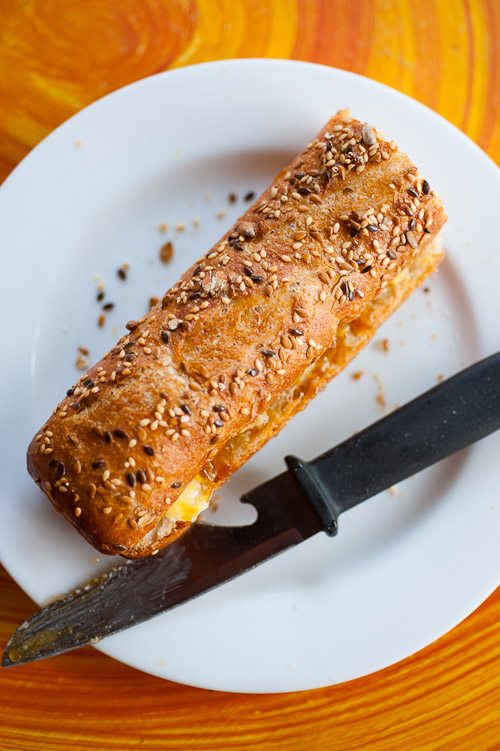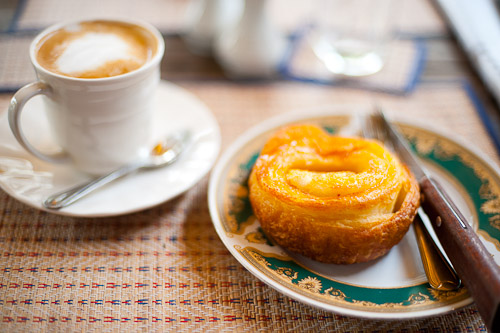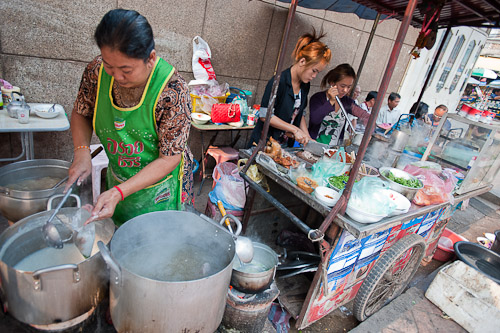 Am back home in Bangkok, for a few days anyway, and one of the places I wanted to eat at and blog about was a restaurant I came upon only relatively recently. Tang Jua Lee is a longstanding restaurant in Bangkok's Chinatown, but since undergoing a relatively recent a face-lift, has something of a modern feel:
Am back home in Bangkok, for a few days anyway, and one of the places I wanted to eat at and blog about was a restaurant I came upon only relatively recently. Tang Jua Lee is a longstanding restaurant in Bangkok's Chinatown, but since undergoing a relatively recent a face-lift, has something of a modern feel:

The restaurant's specialty is hotpots, which come in a few different forms. The tastiest is probably a hotpot of deep-fried fish head meat (tastes much better than it sounds) served in a broth seasoned with dried plum and thin slices of ginger (illustrated at the top of this post). The dried plum (buay in Thai) provides a pleasantly salty tartness that is quite unlike tamarind or lime, the normal souring elements in Thai-style sour soups.
They also do a suki-yaki-type hot pot, where you're provided with a simple broth loaded with a few basic ingredients:

which you supplement with raw ingredients (fish, meat, tofu, veggies, etc.):

I've eaten here three times now and have sampled Tan Jua Lee's non-hot pot dishes, and can confirm that it's the type of place where just about everything is solid. Most recently, in addition to hot pot, we had a dish of Chinese-style pickled veggies:

and a stir-fry of goat meat:

The latter was of the few dishes I've ever encountered in Thailand that used fermented black beans. It was very good, although I'd say that they went a bit overboard with the kheun chai, Chinese celery.
On previous visits I have tried their tasty flash-fried greens:

made Chinese style, with few bells and whistles but with lots of smokey flavour, and their excellent or suan, oyster omelet:

which is rich and garlicky, without being gloopy or overly-eggy.
Tang Jua Lee 2212 Th Khao Lam 02 236 4873 11am-10pm
View Thai Eats in a larger map












 Seen on a roadside in Vang Vieng, Laos. At first I assumed the bra reference was some sort of not-so-subtle sexy advertising technique, but apparently it's meant literally, and according to
Seen on a roadside in Vang Vieng, Laos. At first I assumed the bra reference was some sort of not-so-subtle sexy advertising technique, but apparently it's meant literally, and according to  Talat laeng, evening markets, are, outside of eating at somebody's home, the best place in Laos to find authentic food. The only downside is that, unless you live there, you'll likely need plates, silverware and a place to eat. But if you can manage this, the below are a couple of the better talat laeng in Vientiane.
Talat laeng, evening markets, are, outside of eating at somebody's home, the best place in Laos to find authentic food. The only downside is that, unless you live there, you'll likely need plates, silverware and a place to eat. But if you can manage this, the below are a couple of the better talat laeng in Vientiane.









 Swensens and the Pizza Company officially opened yesterday in Vientiane. They're the first branches of an international fast-food franchise to open in Laos, although it's worth mentioning that this sort of Western food has been available in Vientiane for a while. At least they didn't pull a China or Russia and put them up near some sacred historical district or monument; the restaurants sit virtually next door to the equally tasteless Lao National Culture Hall.
Swensens and the Pizza Company officially opened yesterday in Vientiane. They're the first branches of an international fast-food franchise to open in Laos, although it's worth mentioning that this sort of Western food has been available in Vientiane for a while. At least they didn't pull a China or Russia and put them up near some sacred historical district or monument; the restaurants sit virtually next door to the equally tasteless Lao National Culture Hall. I've been in Vientiane, Laos for the better part of a month now and during this time, my breakfast has hardly diverged from two places. Most days I'll head for Le Banneton, a French bakery in the centre of town. Usually I'll eat in and order their excellent cafe latte (brewed with Lao beans) and a sweet-ish pastry, such as
I've been in Vientiane, Laos for the better part of a month now and during this time, my breakfast has hardly diverged from two places. Most days I'll head for Le Banneton, a French bakery in the centre of town. Usually I'll eat in and order their excellent cafe latte (brewed with Lao beans) and a sweet-ish pastry, such as 


 Sam Euay Nong ('Three Sisters') is a cheery, tidy family-run place in central Vientiane. They do a handful of simple Lao/Vietnamese dishes, ranging from tam mak hung, Lao-style papaya salad, to khao poon nam jaew, thin rice noodles in broth with pork and bamboo, all of which are full of flavour and well executed, but my favourite dish of theirs is probably naem khao.
Sam Euay Nong ('Three Sisters') is a cheery, tidy family-run place in central Vientiane. They do a handful of simple Lao/Vietnamese dishes, ranging from tam mak hung, Lao-style papaya salad, to khao poon nam jaew, thin rice noodles in broth with pork and bamboo, all of which are full of flavour and well executed, but my favourite dish of theirs is probably naem khao.
 Driving along Rte 13 about 25km north of Vang Vieng, I passed by this roadside market, bordered by a stream and shaded by tall limestone cliffs:
Driving along Rte 13 about 25km north of Vang Vieng, I passed by this roadside market, bordered by a stream and shaded by tall limestone cliffs:





 Fishing on the Nam Song, Vang Vieng, Laos
Fishing on the Nam Song, Vang Vieng, Laos Selling CDs near Pha That Luang, Vientiane, Laos
Selling CDs near Pha That Luang, Vientiane, Laos Phở, Vietnamese-style rice noodle soup, is probably the most popular noodle dish in Laos, but a few things set it apart from the dish of its origins. Firstly, the noodles used in Lao phở generally aren't very high quality, and tend to be somewhat coarse and pasty. And Lao phở broth often lacks the deep meatiness of its Vietnamese counterpart (I suspect they attempt to remedy this by adding heaps of MSG). But I reckon the thing that makes Lao phở most different than the Vietnamese style is the number of condiments:
Phở, Vietnamese-style rice noodle soup, is probably the most popular noodle dish in Laos, but a few things set it apart from the dish of its origins. Firstly, the noodles used in Lao phở generally aren't very high quality, and tend to be somewhat coarse and pasty. And Lao phở broth often lacks the deep meatiness of its Vietnamese counterpart (I suspect they attempt to remedy this by adding heaps of MSG). But I reckon the thing that makes Lao phở most different than the Vietnamese style is the number of condiments:
 Boy near Pha That Luang, Vientiane, Laos
Boy near Pha That Luang, Vientiane, Laos  Praying at Wat Si Muang, Vientiane, Laos
Praying at Wat Si Muang, Vientiane, Laos Not from me of course, but from Phia Sing, a former royal cook in the palace of Luang Prabang. The 115 recipes, originally written on notebook paper by Phia Sing, and later compiled and edited by former British diplomat,
Not from me of course, but from Phia Sing, a former royal cook in the palace of Luang Prabang. The 115 recipes, originally written on notebook paper by Phia Sing, and later compiled and edited by former British diplomat,  After two weeks in Vientiane I have to admit that I’ve found relatively little in the way of Lao food worth sharing. I’ve encountered one exceptionally good Lao restaurant, a decent phở' stall and a pretty solid night market, all of which I’ll blog about soon, but for the most part I get the impression that the vast majority of people here appear eat dinner at home, and when eating out, require little more a bit of grilled meat and Beerlao. This is unfortunate for visitors, as Lao food really can be good, but I imagine that much of what people manage to eat here is either gentrified for foreigners, or as is more often the case, just kinda crappy.
After two weeks in Vientiane I have to admit that I’ve found relatively little in the way of Lao food worth sharing. I’ve encountered one exceptionally good Lao restaurant, a decent phở' stall and a pretty solid night market, all of which I’ll blog about soon, but for the most part I get the impression that the vast majority of people here appear eat dinner at home, and when eating out, require little more a bit of grilled meat and Beerlao. This is unfortunate for visitors, as Lao food really can be good, but I imagine that much of what people manage to eat here is either gentrified for foreigners, or as is more often the case, just kinda crappy.
 Recently Global Post Thailand Correspondent
Recently Global Post Thailand Correspondent 
 Inside the Lao Brewery Company, Vientiane, Laos
Inside the Lao Brewery Company, Vientiane, Laos At the Lao Brewery Company outside Vientiane, Laos
At the Lao Brewery Company outside Vientiane, Laos Inside the Lao Brewery Company, Vientiane, Laos
Inside the Lao Brewery Company, Vientiane, Laos  Inside the Lao Brewery Company, Vientiane, Laos
Inside the Lao Brewery Company, Vientiane, Laos Glasses of Beerlao at a restaurant in Vientiane, Laos
Glasses of Beerlao at a restaurant in Vientiane, Laos At the Lao Brewery Company, located outside Vientiane, Laos
At the Lao Brewery Company, located outside Vientiane, Laos I'm updating the next edition of Lonely Planet's Laos guide, and have based myself in Vientiane, that country's capital. I've rented a colonial-era shophouse strategically located within walking distance from an excellent Lao restaurant, a traditional Lao sauna, the city's evening market, two very good French bakeries and the tam maak hung stall illustrated above. I'll most likely in Laos for the better part of the next three months, and you can look forward to dispatches on the places mentioned above, and more.
I'm updating the next edition of Lonely Planet's Laos guide, and have based myself in Vientiane, that country's capital. I've rented a colonial-era shophouse strategically located within walking distance from an excellent Lao restaurant, a traditional Lao sauna, the city's evening market, two very good French bakeries and the tam maak hung stall illustrated above. I'll most likely in Laos for the better part of the next three months, and you can look forward to dispatches on the places mentioned above, and more. After more than a decade in Bangkok, I’m still stumbling upon new entirely new dishes and places to eat. My latest discovery is an obscure intersection near Bangkok’s Chinatown that is home to several restaurants serving kuaytiaw khua kai, a fried noodle dish that’s also a relatively recent discovery of mine. The dish, which consists of wide rice noodles fried with chicken breast and pickled squid and served over lettuce, I first encountered at
After more than a decade in Bangkok, I’m still stumbling upon new entirely new dishes and places to eat. My latest discovery is an obscure intersection near Bangkok’s Chinatown that is home to several restaurants serving kuaytiaw khua kai, a fried noodle dish that’s also a relatively recent discovery of mine. The dish, which consists of wide rice noodles fried with chicken breast and pickled squid and served over lettuce, I first encountered at 






 Northern-style Chinese food is relatively hard to find here in Bangkok. This shouldn't come as a surprise, as most Chinese-Thais trace their roots back to southern China, and anyway, heavy wheat-based food isn't generally the first thing people reach for when they're sweating from every pore. So stumbling upon Khrua Paking (Beijing Kitchen) while actually in search of another restaurant, was a spot of good luck.
Northern-style Chinese food is relatively hard to find here in Bangkok. This shouldn't come as a surprise, as most Chinese-Thais trace their roots back to southern China, and anyway, heavy wheat-based food isn't generally the first thing people reach for when they're sweating from every pore. So stumbling upon Khrua Paking (Beijing Kitchen) while actually in search of another restaurant, was a spot of good luck.



 Located near Bangkok's historic
Located near Bangkok's historic 

 I often get emails from people en route to Bangkok asking me to recommend the best places in town to eat. I reply to these when I can, but sometimes the volume of mail can get overwhelming, so
I often get emails from people en route to Bangkok asking me to recommend the best places in town to eat. I reply to these when I can, but sometimes the volume of mail can get overwhelming, so